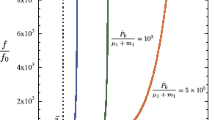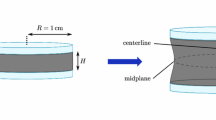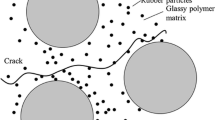Abstract
The principles of the cavitation criteria for rubber particles in polymeric matrices are briefly reviewed. Although these criteria are based on a linear elastic analysis, it is shown that it is possible to extend them to take into account the elastic-plastic behaviour of the matrix. In this objective, the representative volume element of a periodic material was meshed and computations were performed using a finite element method. The results reported in this paper focus mainly on cavitation under uniaxial tension and examine the influence on the hydrostatic stress in the rubber particles of different parameters such as the volume fraction of rubber, the plastic behaviour of the matrix or the ratio of the elastic moduli. In all cases, plastic yielding in the matrix leads to saturation of the hydrostatic stress in the rubber phase. It is also shown that the history of cavitation barely influences the progression of plasticity in the matrix.
Similar content being viewed by others
References
Ball, J.M. (1982). Discontinuous equilibrium solutions and cavitation in nonlinear elasticity. Proceedings Royal Society of London A306, 557–611.
Béguelin, Ph. (1996). Approche expérimentale du comportement mécanique des polymères en sollicitation rapide, Ph.D. Thesis, Ecole Polytechnique Fédérale de Lausanne, Lausanne.
Böhm, H.J., Antretter, A., Eckschlager, A. and Han, W. (1999). Arrangement Effects on Initiation of Particle Failure in Composite Materials with Ductile Matrix, Euromech 402, Micromechanics of Fracture Processes, 25–27 October, 1999, Seeheim, Germany.
Bouton-Rochelle, C. (1991). Etude des mécanismes de déformation plastique dans des mélanges de poly(méthacrylate de méthyle), Ph.D. Thesis, Institut National Polytechnique de Lorraine.
Bowden, P.B. and Oxbourough, R.J. (1973). A general critical-strain criterion for crazing in amorphous glassy polymers. Phil. Mag. 28, 547–--.
Bucknall, C.B., Karpodinis, A. and Zhang, X.C. (1994). A model for cavitation in rubber-toughened plastics. J. Mat. Sci. 29, 3377–3383.
Chang, W.J. and Pan, J. (1997). Cavitation instabilities in plastics and rubber modified plastics. International Journal of Fracture 88, 61–86.
Cheng, C., Hiltner, A., Baer, E., Soskey, P.R. and Mylonakis, S.G. (1995). Cooperative cavitation in rubbertoughened polycarbonate. Journal Mater. Sci. 30, 587–595.
Diani, J. (2001). Irreversible growth of a spherical cavity in rubber-like material: a fracture mechanics description. Int. J. Fract. Mech. 112, 151–161.
Dompas, D. and Groeninckx, G. (1994). Toughening behaviour of rubber-modified thermoplastic polymers involving very small rubber particles: 1. A criterion for internal rubber cavitation. Pol. 35, 4743–4749.
Eshelby, J.D. (1957). The determination of the elastic field of an ellipsoidal inclusion, and related problems. Proceedings Royal Society of London A241, 376–396.
Eshelby, J.D. (1959). The elastic field outside an ellipsoidal inclusion. Proceedings Royal Society of London A252, 561–569.
Fond, C. (2001). Cavitation criterion for rubber materials: a review of void-growth models. J. Pol. Sci. B: Polymer Physics 39, 2081–2096.
Fond, C. (2000). Endommagement des polymères ‘Choc’: modélisation micromécanique et comportements à la rupture, Thèse d'habilitation à diriger des recherches. Université Louis Pasteur, Strasbourg.
Fond, C., Lobbrecht, A. and Schirrer, R. (1996). Polymers toughened with rubber microspheres; an analytical solution for stresses and strains in the rubber particles at equilibrium and rupture. International Journal of Fracture 77, 141–159.
Fond, C., Riccardi, A., Schirrer, R. and Montheillet, F. (2001). Mechanical interaction between spherical inhomogeneities: an assessment of a method based on the equivalent particle. Eur. J. Mech.A/sol. 20, 59–75.
Frank, O. and Lehmann, J. (1986). Determination of various deformation processes in impact-modified PMMA at strain rates up to 105;%/min. Colloid & Polymer Sci. 264, 473–481.
Ganghoffer, J.F. and Schultz, J. (1995). Expansion of a cavity in a rubber block under stress: application of the asymptotic expansion method to the analysis of the stability and bifurcation conditions. International Journal of Fracture 72, 1–20.
Géhant, S. and Schirrer, R. (1999). Multiple light scattering and cavitation in two phase tough polymers. J. Polym. Sci. b. Polym. Physics 37, 113–126.
Géhant, S., Schirrer, R. and Fond, C. (1997). Polymères chocs: dépression hydrostatique dans des inclusions sphériques d'elastomère au-delà du seuil de plasticité de la matrice. Colloque ‘Eléments Finis Polymères’, Ecole des Mines de Nançy.
Géhant, S., Fond, C. and Schirrer, R. (1999). Damage in rubber-toughened polymers: micromechanical simulations of cavitation involving interactions between randomly distributed rubber particles. Euromech 402, Micromechanics of Fracture Processes, Seeheim, Germany.
Green, A.E. and Zerna, W. (1954). Theoretical Elasticity, Oxford University Press, Oxford.
Hou, H.S. and Abeyaratne, R. (1992). Cavitation in elastic and elastic-plastic solids. J. Mech. Phys. Solids 40, 571–592.
Hughes, T.J. and Malkus, D.S. (1983). A general penalty/mMixed equivalence theorem for anisotropic incompressible finite elements. Hybrid and Mixed Finite element Method (Edited by S.. Atluri and O.C. Zienckiewicz) John Wiley & Sons, 487–495.
Lazzeri, A. and Bucknall, C.B. (1993). Dilatational bands in rubber-toughened polymers. J. Mat. Sci. 28, 6799–6808.
Lindsey, G.H. (1967). Triaxial fracture studies. J. Appl. Phys. 38, 4843–4852.
Moulinec, H. and Suquet, P. (1998). A numerical method for computing the overall response of nonlinear composites with complex microstructures. Comput. Methods Appl. Mech. Engrg. 157, 69–94.
Nagtegall, J.C. and Parks, D.M. (1974). On numerically accurate finite element solutions in the fully plastic range. Computer Meth. Appl. Mech. Eng. 4, 153–178.
Read, D.J., Teixeira, P.I.C., Duckett, R.A., Sweeney, J. and McLeish, T.C.B.. (2002). Theoretical and finite-element investigation of the mechanical response of spinodal structures. Eur. Phys. J. E8, 15–31.
Schirrer, R., Fond, C. and Lobbrecht, A. (1996). Volume change and light scattering during mechanical damage in PMMA (Polymethylmethacrylate) toughened with core shell rubber particles. J. Mat. Sci. 31, 6409–6422.
Seelig, Th. and van der Giessen, E. (2002). Localized plastic deformation in ternary polymer blends. Int. J. Solids Struct. 39, 3505–3522.
van der Sluis, O., Schreurs, P.J.G., and Meijer, H.E.H. (2001). Homogenisation of structured elastoviscoplastic solids at finite strains. Mech. Mater. 33, 499–522.
Smit, R.J.M., Brekelmans, W.A.M. and Meijer, H.E.H. (1999). Prediction of the large-strain mechanical response of heterogeneous polymer systems: Local and global deformation behaviour of a representative volume element of voided polycarbonate. J. Mech. Phys. Solids 47, 201–221.
Smit, R.J.M., Brekelmans, W.A.M. and Meijer, H.E.H. (2000). Predicting modelling of the properties and toughness of polymeric materials. Part II – Effect of microstructural properties on the macroscopic response of rubber-modified polymers. J. Mater. Sci. 35, 2869–2879.
Steenbrink, A.C. and van der Giessen, E. (1999). On cavitation, post-cavitation and yield in amorphous polymerrubber blends. J. Mech. Phys. Solids 47, 843–876.
Williams, M.L. and Schapery, R.A. (1965). Spherical flaw instability in hydrostatic tension. Int. J. Fract. Mech. 1, 64–72.
Author information
Authors and Affiliations
Rights and permissions
About this article
Cite this article
Géhant, S., Fond, C. & Schirrer, R. Criteria for cavitation of rubber particles: Influence of plastic yielding in the matrix. International Journal of Fracture 122, 161–175 (2003). https://doi.org/10.1023/B:FRAC.0000005790.35684.1d
Issue Date:
DOI: https://doi.org/10.1023/B:FRAC.0000005790.35684.1d




